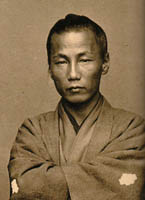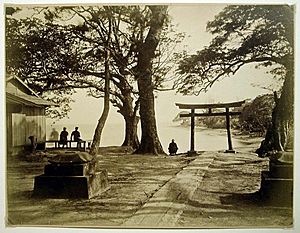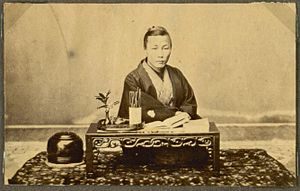Ueno Hikoma facts for kids
Quick facts for kids
Ueno Hikoma
|
|||||
|---|---|---|---|---|---|

Ueno c. 1870s, self-portrait
|
|||||
| Born | October 15, 1838 Nagasaki, Hizen Province, Japan
|
||||
| Died | May 22, 1904 (aged 65) Nagasaki, Nagasaki Prefecture, Japan
|
||||
| Occupation | Photographer | ||||
| Japanese name | |||||
| Kanji | 上野 彦馬 | ||||
| Hiragana | うえの ひこま | ||||
|
|||||
Ueno Hikoma (上野 彦馬 (October 15, 1838 – May 22, 1904)) was a very important early Japanese photographer. He was born in Nagasaki.
Ueno Hikoma was famous for his amazing portraits. He photographed many important Japanese and foreign people. He also took beautiful pictures of landscapes, especially around Nagasaki. Ueno was a key person in Japanese photography during the 1800s. He was successful both in business and art. He also taught many other photographers.
Contents
Ueno Hikoma: Early Life and Photography Training
Ueno Hikoma's family had a history with art. Many of his relatives were portrait painters. His father, Ueno Toshinojō, was a merchant. In 1848, his father brought the first camera to Japan. It was a daguerreotype camera for a powerful leader named Shimazu Nariakira.
In 1852, after his father passed away, Ueno Hikoma started studying at the Nagasaki Medical College. He wanted to learn chemistry. This would help him with his family's business, which involved chemicals and dyeing fabrics. He later studied chemistry with a Dutch naval doctor, J. L. C. Pompe van Meerdervoort. This doctor also taught Ueno Hikoma about photography.
Learning Photography from Experts
Ueno decided to become a photographer after meeting a Swiss photographer named Pierre Rossier. Rossier was in Japan from 1859 to 1860. He taught Ueno and others about the "wet-collodion process" of photography. This was a new way to take pictures.
Soon after, Ueno's friend Horie Kuwajirō bought a wet-plate camera. It cost a lot of money, about 150 ryō. This was paid for by a powerful leader named Tōdō Takayuki. Ueno was so interested in the camera that he moved to Edo (now Tokyo) to use it.
In 1861, Horie photographed Ueno working in a lab. In 1862, Ueno and Horie wrote a textbook together. It included a section called "The Technique of Photography." This section explained how to use the collodion process.
Ueno Hikoma's Photography Career
After working in Edo, Ueno returned to Nagasaki. He decided to become a full-time photographer. In the autumn of 1862, Ueno opened his own photography studio. It was located by the Nakashima River in Nagasaki. He also started bringing cameras into Japan from other countries.
At first, his business was slow. But it slowly grew bigger. In 1882, he moved his studio to a larger building. His studio became very popular with both Japanese and foreign visitors. Famous writers even mentioned his studio in their books. Foreigners visiting Japan helped Ueno earn more money. This allowed him to buy better materials and make his studios bigger.
Photographing Important Figures
In the early days of photography in Japan, many people were shy about being photographed. But Ueno convinced many important people to pose for him. He took pictures of famous figures like Sakamoto Ryōma and Itō Hirobumi. He also photographed Ulysses S. Grant, a former U.S. President, in 1879. In 1891, he photographed the Russian crown prince, who later became Tsar Nicholas II. Ueno's studio stayed open until the end of the 1800s.
Ueno worked closely with another famous photographer, Felice Beato. When Beato visited Nagasaki, he used Ueno's studio. They even exchanged photographs. Ueno likely improved his skills by working with Beato. Other foreign photographers also helped Ueno. These included Konrad Walter Gratama and Wilhelm Burger.
Teaching and Expanding His Work
Ueno Hikoma taught many important photographers of the 1800s. Some of his students included Uchida Kuichi and Tomishige Rihei. Ueno stayed close with Uchida. They even shared some of their photographs. Later, Ueno opened more studios in other countries. He had branches in Vladivostok (1890), Shanghai (1891), and Hong Kong (1891).
Besides portraits, Ueno took many pictures of Nagasaki and its surroundings. He also photographed the transit of Venus across the sun in 1874. This was for an American astronomy team. In 1877, he was hired to take pictures of battlefields during the Satsuma Rebellion. He was paid ¥330 for 420 photos.
Ueno showed his photographs at big events called World Expositions. He exhibited at the Vienna World Exposition in 1873 and the World Columbian Exposition in Chicago in 1893. In Chicago, he won an award for his "Good Taste and Artistic Finish."
Ueno first used "wet-plate photography." But around 1877, he started using "dry plates" from Belgium. Most of Ueno's photos were not colored by hand. He thought French and American photography tools were better than British ones. He also thought British products were too expensive.
Some of Ueno's old photo negatives were later bought by another photographer, Kusakabe Kimbei. Ueno didn't usually sell photo albums. But he made some special albums for foreign customers who asked for them.
Remembering Ueno Hikoma
In 2000, the "Kyushu Sangyo University Photo Contest" created the "Ueno Hikoma Award." This award helps find and support new photographers. It was made to celebrate the 40th anniversary of Kyushu Sangyo University.






